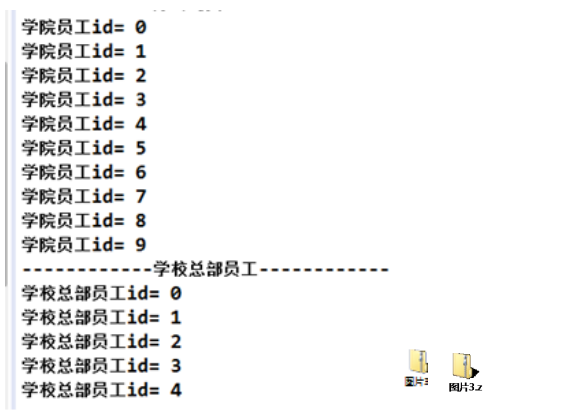1.1 基本介绍
1) 一个对象应该对其他对象保持最少的了解
2) 类与类关系越密切,耦合度越大
3) 迪米特法则(Demeter Principle)又叫最少知道原则,即一个类对自己依赖的类知道的
越少越好。也就是说,对于被依赖的类不管多么复杂,都尽量将逻辑封装在类的内
部。对外除了提供的public 方法,不对外泄露任何信息
4) 迪米特法则还有个更简单的定义:只与直接的朋友通信
5) 直接的朋友:每个对象都会与其他对象有耦合关系,只要两个对象之间有耦合关系,
我们就说这两个对象之间是朋友关系。耦合的方式很多,依赖,关联,组合,聚合
等。其中,我们称出现成员变量,方法参数,方法返回值中的类为直接的朋友,而
出现在局部变量中的类不是直接的朋友。也就是说,陌生的类最好不要以局部变量
的形式出现在类的内部。
1.2 应用实例
1) 有一个学校,下属有各个学院和
总部,现要求打印出学校总部员
工ID和学院员工的id
2) 编程实现上面的功能, 看代码演示

3)代码演示
package com.atguigu.principle.demeter;import java.util.ArrayList;import java.util.List;//客户端public class Demeter1 {public static void main(String[] args) {//创建了一个 SchoolManager 对象SchoolManager schoolManager = new SchoolManager();//输出学院的员工id 和 学校总部的员工信息schoolManager.printAllEmployee(new CollegeManager());}}//学校总部员工类class Employee {private String id;public void setId(String id) {this.id = id;}public String getId() {return id;}}//学院的员工类class CollegeEmployee {private String id;public void setId(String id) {this.id = id;}public String getId() {return id;}}//管理学院员工的管理类class CollegeManager {//返回学院的所有员工public List<CollegeEmployee> getAllEmployee() {List<CollegeEmployee> list = new ArrayList<CollegeEmployee>();for (int i = 0; i < 10; i++) { //这里我们增加了10个员工到 listCollegeEmployee emp = new CollegeEmployee();emp.setId("学院员工id= " + i);list.add(emp);}return list;}}//学校管理类//分析 SchoolManager 类的直接朋友类有哪些 Employee、CollegeManager//CollegeEmployee 不是 直接朋友 而是一个陌生类,这样违背了 迪米特法则class SchoolManager {//返回学校总部的员工public List<Employee> getAllEmployee() {List<Employee> list = new ArrayList<Employee>();for (int i = 0; i < 5; i++) { //这里我们增加了5个员工到 listEmployee emp = new Employee();emp.setId("学校总部员工id= " + i);list.add(emp);}return list;}//该方法完成输出学校总部和学院员工信息(id)void printAllEmployee(CollegeManager sub) {//分析问题//1. 这里的 CollegeEmployee 不是 SchoolManager的直接朋友//2. CollegeEmployee 是以局部变量方式出现在 SchoolManager//3. 违反了 迪米特法则//获取到学院员工List<CollegeEmployee> list1 = sub.getAllEmployee();System.out.println("------------学院员工------------");for (CollegeEmployee e : list1) {System.out.println(e.getId());}//获取到学校总部员工List<Employee> list2 = this.getAllEmployee();System.out.println("------------学校总部员工------------");for (Employee e : list2) {System.out.println(e.getId());}}}
1.3 应用实例改进
1) 前面设计的问题在于SchoolManager中,CollegeEmployee类并不是
SchoolManager类的直接朋友 (分析)
2) 按照迪米特法则,应该避免类中出现这样非直接朋友关系的耦合
3) 对代码按照迪米特法则 进行改进
4) 代码演示
package com.atguigu.principle.demeter.improve;import java.util.ArrayList;import java.util.List;//客户端public class Demeter1 {public static void main(String[] args) {System.out.println("~~~使用迪米特法则的改进~~~");//创建了一个 SchoolManager 对象SchoolManager schoolManager = new SchoolManager();//输出学院的员工id 和 学校总部的员工信息schoolManager.printAllEmployee(new CollegeManager());}}//学校总部员工类class Employee {private String id;public void setId(String id) {this.id = id;}public String getId() {return id;}}//学院的员工类class CollegeEmployee {private String id;public void setId(String id) {this.id = id;}public String getId() {return id;}}//管理学院员工的管理类class CollegeManager {//返回学院的所有员工public List<CollegeEmployee> getAllEmployee() {List<CollegeEmployee> list = new ArrayList<CollegeEmployee>();for (int i = 0; i < 10; i++) { //这里我们增加了10个员工到 listCollegeEmployee emp = new CollegeEmployee();emp.setId("学院员工id= " + i);list.add(emp);}return list;}//输出学院员工的信息public void printEmployee() {//获取到学院员工List<CollegeEmployee> list1 = getAllEmployee();System.out.println("------------学院员工------------");for (CollegeEmployee e : list1) {System.out.println(e.getId());}}}//学校管理类//分析 SchoolManager 类的直接朋友类有哪些 Employee、CollegeManager//CollegeEmployee 不是 直接朋友 而是一个陌生类,这样违背了 迪米特法则class SchoolManager {//返回学校总部的员工public List<Employee> getAllEmployee() {List<Employee> list = new ArrayList<Employee>();for (int i = 0; i < 5; i++) { //这里我们增加了5个员工到 listEmployee emp = new Employee();emp.setId("学校总部员工id= " + i);list.add(emp);}return list;}//该方法完成输出学校总部和学院员工信息(id)void printAllEmployee(CollegeManager sub) {//分析问题//1. 将输出学院的员工方法,封装到CollegeManagersub.printEmployee();//获取到学校总部员工List<Employee> list2 = this.getAllEmployee();System.out.println("------------学校总部员工------------");for (Employee e : list2) {System.out.println(e.getId());}}}
1.4 迪米特法则注意事项和细节
1) 迪米特法则的核心是降低类之间的耦合
2) 但是注意:由于每个类都减少了不必要的依赖,因此迪米特法则只是要求降低
类间(对象间)耦合关系, 并不是要求完全没有依赖关系

